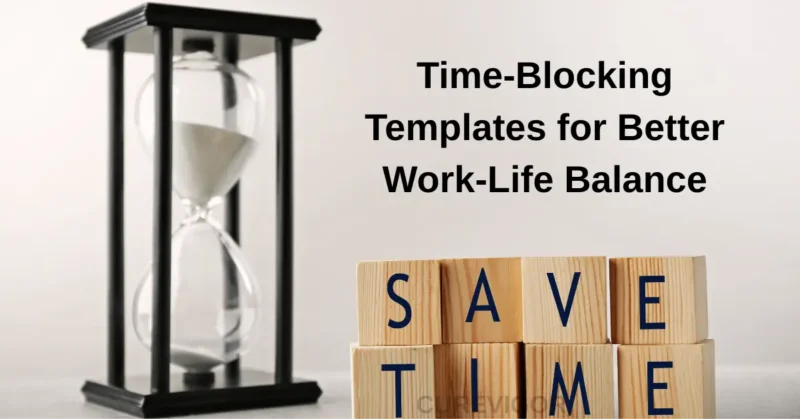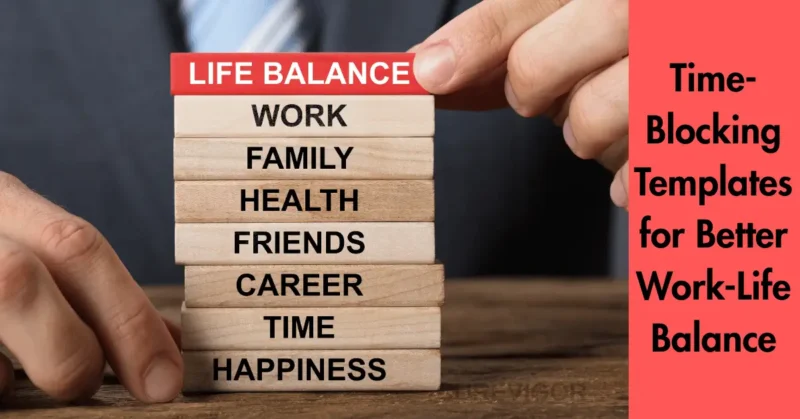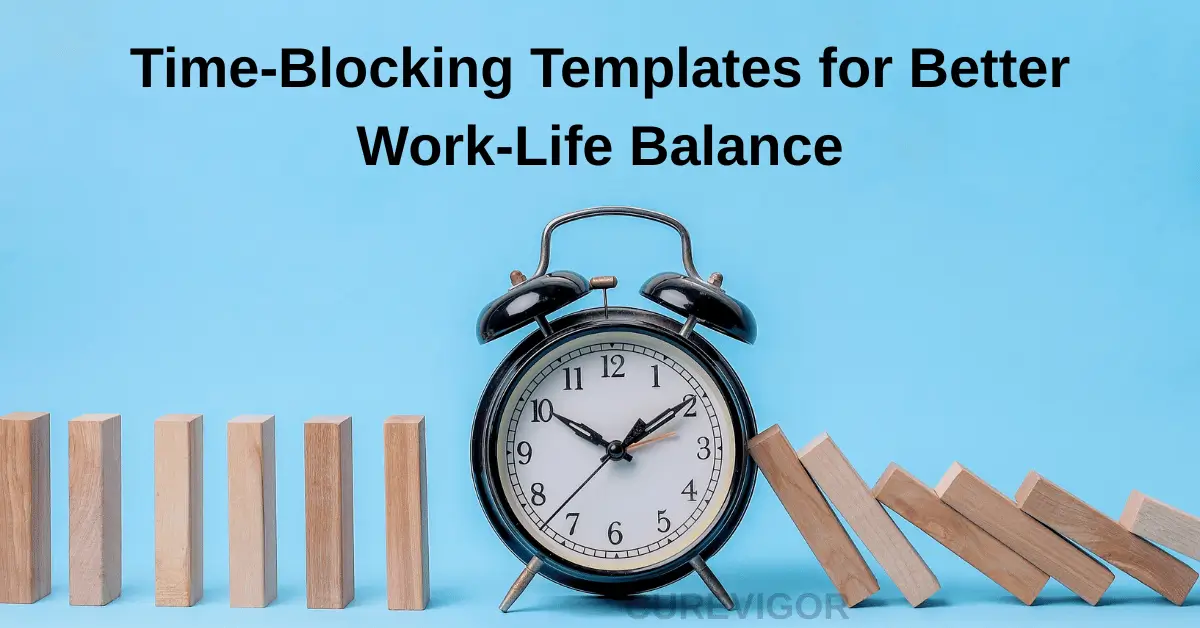Time-blocking isn’t just a productivity trend — it’s a mindset shift that gives you control over your time instead of letting tasks and distractions control you.
Thank you for reading this post, don't forget to subscribe!From entrepreneurs and students to corporate professionals and busy parents, this method is becoming a must-have tool for designing a balanced, high-productivity life.
In today’s fast-moving world, finding a healthy work-life balance feels like chasing a mirage. But what if you could carve out intentional time—blocks of it—that serve your deepest goals, not just your inbox?
That’s the power of time-blocking, a scheduling strategy that many productivity experts swear by. In this post, we’ll explore what time-blocking is, why it works, and then dive into 10 practical templates you can implement right away to boost productivity and nourish your life outside work.
What Is Time-Blocking?
Time-blocking involves assigning blocks of time to specific tasks, priorities, and personal routines. Instead of reacting to your day as it unfolds, you proactively plan it, giving every hour a job.
By working in structured time blocks — whether for a creative task, admin work, or rest — you reduce mental clutter, protect your focus, and get more done in less time.
Put simply: time-blocking turns your to-do list into a real schedule, not a wish list.
And yes — it looks beautiful on paper…
But the magic happens when you actually practice it.

Benefits:
- You reduce distractions and context-switching: Each block has one purpose. When you constantly switch tasks, your brain wastes effort refocusing. Studies show frequent context-switching hurts productivity.
- You improve focus and create conditions for deeper work: When you block uninterrupted time, you’re more likely to enter a “flow” state.
- You gain more control and better work-life balance: By planning your time, you free up space for meaningful things beyond work—family time, hobbies, rest. For example, one faculty member said that after time-blocking, she started enjoying things she had never done before, without guilt.
- You become intentional rather than reactive: Instead of letting urgent tasks drive you, you decide what matters and when.
In short, time-blocking helps you align your time with your priorities, live more deliberately, and reclaim balance.
How Does Time-Blocking Work?
Time-blocking transforms your calendar from a list of appointments into a daily success blueprint.
Instead of bouncing between emails, messaging apps, and random tasks, you intentionally decide:
- What you’ll work on
- When you work on it
- How long will you give it
- What you won’t do during that time
This eliminates the “What should I work on now?” hesitation that wastes precious energy and time.
When you block time, you reserve mental space for one activity at a time. For example:
- 9:00–11:00 AM: Write content or handle creative work
- 11:00–12:00 PM: Emails and messages
- 1:00–3:00 PM: Client meetings or deep work
- 3:00–4:00 PM: Planning, admin, or personal tasks
As productivity experts emphasize, time-blocking lets you shift from reactive living (responding to everything that pops up) to intentional working (you choose what matters, when it matters).
Rachel Hakoune from Monday.com summarizes it well: time-blocking builds a structured work rhythm so you can enter a state of flow without constant interruptions or decision fatigue.
But what’s flow — or “deep work” — really?
The term deep work was popularized by author Cal Newport. It describes stretches of intense focus where distractions fade, your mind sharpens, and you produce higher-quality results in less time.
Newport argues that:
A strategically time-blocked 40-hour workweek can outperform an unstructured 60+ hour one.
In a world where our attention is constantly under attack, this ability to focus is no longer optional — it’s a superpower.
Time-blocking trains your brain to protect that mental space.
Why Time-Blocking Matters More Than Ever
We live in an age of constant notifications, endless scrolling, and multitasking disguised as productivity.
Every buzz, ping, or pop-up steals a bit of your attention — and your momentum.
Research from King’s College London found that most adults underestimate how often they check their phones. While participants guessed they check their phones around 25 times a day, actual data revealed it’s closer to 80 unlocks per day for the average iPhone user.

That’s nearly once every 12 minutes — and it’s costing us dearly.
- 50% of survey respondents admitted they can’t stop checking their phones even when they should be focused.
- 47% felt that “deep thinking” has become nearly impossible in the modern attention economy.
Across the Atlantic, the numbers tell a similar story. In the U.S., 47% of people say they’re “addicted” to their smartphones, while 70% check their phone within five minutes of receiving a notification.
With an average of 46+ notifications per day, no wonder productivity and mental clarity are taking a hit.
This constant fragmentation of focus leads to:
- Shallow work instead of meaningful progress
- Chronic stress and overwhelm.
- Less creativity and problem-solving power
- Declining work-life balance
How Time-Blocking Reclaims Your Focus
Time-blocking acts like a mental firewall between you and distraction.
When you assign specific blocks to each type of work, you:
- Give your brain a clear target.
- Limit context-switching
- Set boundaries for distractions.
- Create a rhythm of focus and rest.
You’re no longer reacting to your day — you’re designing it.
This method doesn’t just boost productivity; it also builds intentional balance. You can schedule work, exercise, meals, creative time, and even rest blocks so that every part of your life gets protected space.
Why It Works for Every Lifestyle
One of the biggest strengths of time-blocking is its flexibility.
Whether you’re:
- Managing a corporate team
- Running a side hustle
- Studying full-time
- Working from home
- Balancing career and parenting
There’s a time-blocking approach that can fit your rhythm.
You can create hourly, daily, or weekly templates — even blocks for habits like journaling, fitness, or family time. It’s not about rigid scheduling; it’s about intentional energy use.
Time-blocking turns your calendar into a reflection of your values — not just your obligations.
The Hidden Psychology Behind Time-Blocking
Here’s why time-blocking works so well from a cognitive standpoint:
- Reduces Decision Fatigue: You make dozens of small scheduling decisions daily. Time-blocking eliminates most of them — you already know what to do next.
- Triggers Commitment: When something has a specific time assigned, you’re more likely to treat it seriously (just like an appointment).
- Reinforces Flow States: Continuous, uninterrupted focus allows your brain to enter “flow” — a mental zone where productivity skyrockets.
- Improves Emotional Control: Having structure reduces anxiety because you no longer feel pulled in 10 directions.
- Builds a Sense of Progress: Seeing your day visually segmented into meaningful blocks reinforces motivation.
So, Can Time-Blocking Work for You?
Yes — and you can start small.
Begin by blocking just your most important 3–4 hours each day for focused, high-value work.
Then expand to include breaks, creative time, and personal life routines.
Soon you’ll notice:
- You finish tasks faster.
- You stress less
- You finally feel balanced between work and life.
Time-blocking doesn’t demand perfection — only intention and consistency.
Final Thought
In a world overflowing with distractions, focus is the new superpower.
And time-blocking is your tool to reclaim it.
Every minute you schedule intentionally is a step away from chaos — and closer to calm, clarity, and true productivity.
10 Time-Blocking Templates for Better Work-Life Balance
Here are ten powerful templates you can plug into your schedule. Each one addresses a specific dimension of productivity or balance. Use them as inspiration, adapt them to your context, and rotate them as needed.
Use these templates in planners, Google Calendar, Notion, Excel, or digital time-blocking apps.
1. The Urgent-Important Decision Template (Prioritization / Eisenhower Method)
Best for: People overwhelmed by too many tasks and unclear priorities.
This template blends time-blocking with the Eisenhower Priority Matrix so each time slot has a purpose.
Block categories:
- Urgent & Important — do now.
- Important but Not Urgent — schedule for deep focus
- Urgent but Not Important — delegate or quick actions
- Not Urgent & Not Important — eliminate/limit
Example Daily Layout
| Time Block | Activity Type |
| 9:00–11:00 AM | Major project task (Important & Urgent) |
| 11:30–12:00 PM | Communication/calls (Urgent but Less Important) |
| 1:00–3:00 PM | Strategy / Learning / Long-term project (Important but Not Urgent) |
| 4:00–4:30 PM | Emails / quick fixes / admin tasks |
| Evening | Personal time/relationships / rest |
Why it works: Keeps your brain from being hijacked by low-value “urgent” tasks.
2. The Pomodoro Interval Template (Focus & Deep Work)
Best for: People who are easily distracted or dealing with screen fatigue.
Break your day into focus sprints and rest periods:
Pomodoro Structure
- 25 minutes of deep work
- 5-minute break
- After 4 cycles → 15–30 minute break
Sample Time-Blocked Cycle
| Block | Task |
| 9:00–9:25 | Write blog section |
| 9:25–9:30 | Break |
| 9:30–9:55 | Research |
| 9:55–10:00 | Break |
Why it works: Short bursts help you sustain attention without burnout.
3. The Task-Batching Template (Efficiency-Boost)
Best for: Business owners, content creators, professionals with repeat tasks.
Batch similar types of tasks instead of switching between them.
Example Categories
- Creative work block
- Calls & meetings block
- Emails & admin block
- Planning block
- Personal errands block
Sample
| Time | Batch Focus |
| 9–11 AM | Content writing |
| 12–1 PM | Emails + CRM |
| 2–4 PM | Client calls & meetings |
| 5–6 PM | Errands / dinner prep |
Why it works: Reduces context switching — your brain stays in the same mode longer.
4. The Day-Theming Template (Weekly Structure)
Best for: Entrepreneurs, freelancers, and content teams.
Each day focuses on a theme rather than juggling everything daily.
| Day | Theme |
| Monday | Planning & strategy |
| Tuesday | Meetings/calls / networking |
| Wednesday | Content creation |
| Thursday | Meetings/calls/networking |
| Friday | Admin + reviews + early finish |
Why this matters:
It helps you reduce decision-fatigue and give your week a predictable structure. When you know “this day is for X”, you show up more ready.
Template 5: The Self-Care Template (Essential Balance Block)
Work-life balance isn’t just about work; it’s about ensuring life beyond work. Block time specifically for rest, health, and enjoyment.
What this block looks like:
- A daily or every-other-day block for “self-care”: exercise, mindfulness, reading, a hobby, family.
- Perhaps a morning or evening block, e.g., 6:00-7:00 pm unwind; or 7:00-8:00 am workout.
- Also include weekly blocks for longer rest: e.g., Sunday afternoon “digital-free walk”.
Template Outline
| Block | Focus |
| Morning | Movement + nourishing breakfast |
| Mid-day | Hydration + unplug break |
| Evening | Relaxation/wind-down |
| Weekly | Dedicated self-care day/hour |
Why it works: Without intentional self-care, productivity collapses. This protects your energy foundation.
Template 6: The Balanced Morning Routine (New & Actionable Start)
How you start your day often shapes the rest of it. Use a time-block template for a morning routine that blends productivity and life.
Example template:
- 6:00-6:30: Wake up + hydration + light movement
- 6:30-7:00: Mindfulness or journaling
- 7:00-8:00: Deep work (your “one thing”)
- 8:00-8:30: Breakfast + family time
- 8:30-9:00: Planning/day review
Why implement this:
A structured morning sets the tone, gives you uninterrupted time for your highest-value work before the world intrudes, and ensures you incorporate life-balancing habits early.
Template 7: The Mindful Workday (New & Comprehensive Structure)
This is a full-day time-blocking plan designed to integrate work, breaks, transitions, and life.
Sample blocks:
- 9:00-10:30: Deep work
- 10:30-10:45: Short break (walk, water)
- 10:45-12:00: Collaboration/meetings
- 12:00-13:00: Lunch + refresh
- 13:00-14:30: Focus block (solo tasks)
- 14:30-14:45: Break
- 14:45-16:00: Admin/emails
- 16:00-17:00: Wind-down/plan next day
- 17:00-18:00: Self-care block (exercise, hobby)
- Evening: Family/time off
Why this structure helps:
It respects your natural energy rhythms, prevents over-extension, and explicitly includes time for transitions and rest, thereby contributing to better work-life balance.
Template 8: The Weekend Recharge (New & Critical for Balance)
Weekends are often the only time we can step away from work—but without structure, they can become chaotic or feel “off”.
Template idea:
- Saturday morning: Longer self-care/hobby block (2-3 hours)
- Saturday afternoon: Leisure/family
- Sunday morning: Light planning block (30-60 min) for the week ahead
- Sunday afternoon: Digital-free or low-tech block (walk, reading)
- Sunday evening: Early wind-down, bedtime routine
Why it matters:
By time-blocking your weekend, you ensure both rest and preparation for the coming week—so you start Monday refreshed and balanced rather than reactive.
Template 9: The Digital Detox Day (New & Addresses Modern Overload)
We live in a hyper-connected world; email, social media, notifications, remote work—these blur boundaries.
Plan a block or full day (e.g., Saturday afternoon or Sunday):
- Block time: Turn off alerts, schedule no inbox checks for a set window (or full day)
- Use the block for an analog or low-tech activity (walk, hobby, face-to-face time)
- Follow with an intentional return: review notifications, but only after your block ends.
Benefit:
It gives your brain a rest, creates space for genuine recovery and reflection, and helps reinforce the boundary between work/leisure.
Template 10: The Transition Block Template (Moving between tasks/work/life)
Transitions often get neglected, but they’re crucial. Moving from one task to another, or from work mode to life mode, deserves its block.
How to use it:
- At the end of your workday, schedule a 15-minute “transition” block: close tabs, plan tomorrow, tidy your workspace, and shift your mindset.
- At the start of your leisure time, schedule a “decompression” block: maybe a short walk, a change of clothes, a mental check-out.
- At the end of your week (Friday afternoon), schedule a “week-wrap” block: review wins, lessons, and what to carry into next week.
Why this matters:
Without transitions, you bleed one mode into another—work into life, or vice versa—leading to stress, blurred boundaries, and eventual burnout.
Tips for Implementing Time-Blocking
Here are practical tips to help you adopt time-blocking effectively:
- Be realistic: Estimate time blocks based on how long tasks actually take, not how long you wish they’d take. Many people underestimate.
- Be flexible: Life happens. Unexpected tasks or interruptions may require you to adjust your blocks. Leave buffer time.
- Prioritize self-care: As you’ve seen above, blocks for rest, exercise, and digital detox matter. They aren’t optional if you want balance.
- Review regularly: Reflect daily or weekly on what blocks worked, what didn’t, and refine your schedule.
- Communicate boundaries: If you work with others, let them know your blocked focus times so they respect them (or you can reschedule).
- Use the right tools: Calendar apps (Google Calendar, Outlook), planners, and time-tracking apps can help.
- Align with energy rhythms: We all have times of peak focus and times when we’re less sharp. Block your “deep work” during your high-energy slots.
- Mix work and life blocks: Remember, the goal isn’t just more work, it’s a better balance. So include blocks that reflect your values beyond tasks.
Common Time-Blocking Mistakes to Avoid
Here are pitfalls to watch out for:
- Over-scheduling: Packing every minute with tasks leaves no space for spontaneity, rest, or creativity. You’ll feel overwhelmed.
- Not leaving buffer time: If you schedule back-to-back blocks without gaps, any delay or interruption cascades.
- Rigidity over flexibility: It’s good to have structure, but if you can’t adjust when things change, time blocking can become rigid and stressful.
- Ignoring review and adjustment: Without periodic check-ins, you’ll keep repeating what isn’t working.
- Neglecting self-care and transitions: If you skip blocks for breaks, transitions, or leisure, you’re likely to burn out.
- Underestimating task durations: It’s common to schedule something for 30 minutes when it actually takes 60 because of interruptions or complexity.
- Failing to protect focus blocks: Allowing distractions during your “deep work” blocks defeats the purpose of time-blocking.
Conclusion
If you’ve ever felt overwhelmed, as though your day runs you rather than you running your day, time-blocking offers a powerful remedy. By dedicating explicit chunks of time to important tasks, rest, transitions, and meaningful life activities, you reclaim control.
The “Boost Productivity: 10 Time-Blocking Templates for Better Work-Life Balance” list gives you a rich toolkit—try one or two templates this week, see what works, and adapt them.
Over time, you’ll likely find that not only your output improves, but your sense of balance, calm, and satisfaction does too.
Take the first step: pick a template, block your next week’s calendar, protect those blocks, review after seven days—and keep going.
If you’ve ever felt like the day slips away faster than you can chase it, time-blocking might be the strategy you’ve been missing.
You don’t need more hours — you need better structure and mindful planning.
Try one template this week.
Master your time — and your life transforms with it.
Time-Blocking Templates Download
Read more practical tips on Health and Balance.
You might love:

